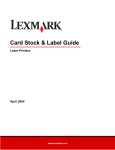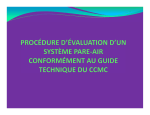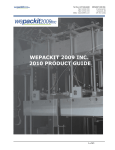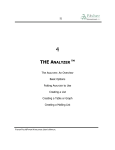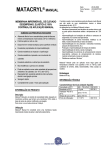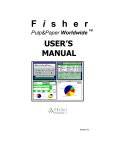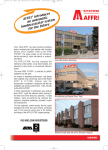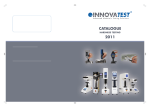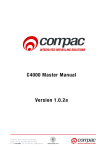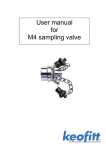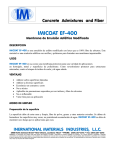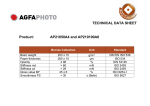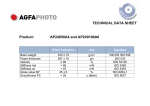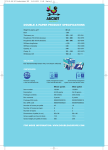Download Section 5 - Testing Machines, Inc.
Transcript
TESTING MACHINES, INC. The Finest Test Equipment for all Industries www.testingmachines.com Section 5 ‐ Paper Surface Testing Application Information This section deals with instruments that test the surface structure and integrity of paper or board. These instruments also help determine the effect of these properties on paper functions. For example, although the roll hardness tester is applied to the surface, it measures a z‐direction parameter, the winding tension, which is important to the properties of the web as a whole and to subsequent processing. The surface characteristics of a sheet of paper or board are dependent not only upon the forming, coating and finishing processes, but on many of the fundamental fiber properties and changes they experience during the manufacture of the product. From a macro perspective, smoothness relates to the formation of a sheet, which is governed by: the morphology of the fibers their treatment during stock preparation the effect of chemical additives the forming characteristics of the paper or board machine From a micro perspective, factors such as MG cylinder glazing, coating, machine calendering and off‐machine supercalendering all contribute to a reduction in surface roughness. All these characteristics similarly affect air permeability due to closing up the surface and increasing sheet density. In addition, any loading to the paper will add more changes in permeability. Softness is less easy to define since it tends to be more subjective in character. Smoothness, flexibility and compressibility are all functions that affect softness and hence all parameters that affect these are likely to be relevant. Surface integrity is particularly important for printing papers. The surface fibers must be sufficiently bonded to those beneath the surface and the coating bond to the fiber matrix must be sound. Roll hardness is mainly a function of the reeling tension at the end of the paper or board machine. Low tension results in a loose, flabby and uncontrollable reel. Over‐tensioning gives a hard reel causing stresses in the web which can ultimately result in collapse of the reel. MONITOR SMOOTHNESS II Product link: http://www.testingmachines.com/product/58‐24‐monitor‐smoothness‐ii Application Roughness (the inverse of smoothness) relates to all stages of the manufacturing process. Flocculation produces fiber clumps whose frequency and amplitude give variations in micro‐caliper. Factors include: fiber furnish treatment during stock preparation chemicals added discharge of stock onto the machine wire characteristics of the wet end itself The random manner in which the fibers are deposited and the dimensions of the fibers themselves further contribute to roughness giving variations with higher frequency but lower amplitude. After the wet end, the processing parameters are used to smooth out the variations that cause roughness. Wet pressing compacts the sheet, increasing the conformability of the fibers and bonding potential. The sheet is stabilized during drying but the surface polishing introduced by machine glazing, calendering and supercalendering flattens the surface fibers and smoothes out the variations in micro‐caliper. For papers needing very smooth surfaces, clay coating is applied and leveled by means of an air knife or blade. The smoothest surface is achieved by casting coating where the mix is dried in contact with a highly polished cylinder. Whereas all papers need a certain degree of surface smoothness, the primary need is with high quality printings where even microscopic imperfections show up as printing defects and the paper will be rejected. Air permeance, conversely, requires an open sheet formed with inflexible fibers, minimal fiber treatment and no loading or coating. These characteristics are normally only found in filter papers but for the majority of papers, a compromise set of characteristics has to be chosen. Quality control of these parameters requires that frequent testing be carried out. Softness is a property that tends to be subjective in character but generally relates to bulk compressibility, flexibility and smoothness, again giving rise to a compromise situation. The most common method of testing for smoothness is by the Air leak method. Air flows between parallel surfaces at a rate proportional to the cube of the gap between them and this can be used to estimate the cube root mean distance between the material test piece and a polished metering land. The advantage of this system is that results are weighted strongly by deeper pits in the paper surface which most affect print quality. In measuring roughness by this method, variations in caliper and permeability have significant effect. Consequently, the designs of instruments reflect the need to overcome this problem. The use of a sensing head fitted with wide metering lands with hard backing material tends to accentuate the micro‐caliper component of roughness, whereas an instrument with narrow lands and hard backing reduces this influence. With this geometry, however, the lands tend to rest on the thickest part of the paper increasing the effect of formation. The use of rigid backing also increases the influence of airflow through the sheet. To eliminate this airflow effect, narrower lands protected by concentric guard rings are used in the Print‐Surf instrument. In addition, a backing that is deformable under pressure is fitted, providing the same roughness pattern experienced under printing conditions. All the instruments listed below conform to National and International Standards. Different standards may apply to the various instruments, however. Again, although all instruments may be used to measure the smoothness (or roughness) of all relevant papers and boards, specific instruments may be better suited for individual purposes. BENDTSEN ROUGHNESS AND AIR PERMEANCE TESTER Product link: http://www.testingmachines.com/product/58‐27‐bendtsen‐roughness‐tester Bendtsen Roughness is achieved by clamping the test piece between a flat glass plate and a circular metal land and measuring the rate of airflow between the paper and land, the air being supplied at a nominal pressure of 1.47 kPa. Bendtsen Air Permeance is measured as the mean airflow through an area of 10 cm2 of the test piece clamped between the land and a circular gasket. The measuring land has an internal diameter of 31.5 mm +/‐ 0.2mm. and a width of 150 μm +/‐ 2 μm. The pressure exerted on the test piece by the land is 170 kPa. Air pressure is supplied from an electrically operated compressor. Users must specify either 110V, 60Hz, single phase or 220/240V, 50Hz, single phase power supply. The microprocessor controlled tester has been redesigned to overcome a number of problems associated with the original Bendtsen tester. Errors due to mechanical instability and air turbulence within the measuring head have been eliminated. The effect of internal air resistance in the traditional design makes the actual measuring pressure drop to an uncontrollable level. By controlling this pressure in the newly designed measuring head directly over the paper surface this effect is eliminated and the exact standard value can be guaranteed. In the new instrument, the input of test details and working instructions to the computer are made by user friendly menu driven software instructions. When the instrument has been set up, the operation of each test is carried out automatically. The results are indicated on a liquid crystal display and may be transmitted to data acquisition system via the RS232C output. Hardness (inverse of softness) is an additional parameter that is available by measuring the ratio of airflow obtained with standard and 490 kPa pressures applied to the land. In this case only the ratio, or hardness value, is transmitted in the RS232 string and not the individual airflow. Software is available for use with a PC running Windows3.1 or higher. Users must specify either 110V, 60Hz, single phase or 220/240V, 50Hz, single phase power supply. Compressed air between 400 and 600 kPa is supplied from the compressor included with instrument. The tester conforms to the following standard procedures: Roughness ISO 8791/2, SCAN P21, BS4420, DIN 53108 Air Permeance ISO 5636‐3, DIN 53120 MONITOR SMOOTHNESS II Sheffield Roughness is achieved by clamping the test piece between a flat glass plate and a circular metal land and measuring the rate of airflow between the paper and land. The air being supplied at a nominal pressure of 10.34 kPa. Sheffield Air Permeance is measured as the mean airflow through a test piece clamped between two circular gaskets. The exposed area of sample is controlled by the inside diameter of the gaskets. The gaskets are available in 5 common sizes (9.5 mm, 19.1 mm, 38.1 mm, 57.2 mm, 76.2 mm) The concentric annular lands of the smoothness measuring head are 0.380 mm +/‐ 0.010 mm. The outer diameters of the measuring lands are 47.07 mm +/‐0.03 mm and 34.37 mm +/= 0.03 mm respectively. The total mass of the measuring head is 1.64‐kg +/‐ 0.005 kg. Users must specify either 110V, 60Hz, single phase or 220/240V, 50Hz, single phase power supply. The Monitor Smoothness II has been designed as a direct replacement for the older style flow tube models. It is fully compatible with existing smoothness and porosity test stations and calibrates in Sheffield units using a standard master orifice manifold. The Monitor Smoothness II contains a mass flow meter and can measure in SCCM’s. The instrument’s design eliminates the need for the mercury manometer present in older style devices. The instrument can be programmed to correct for variations in air temperature and barometric pressure improving the accuracy of measurement. The Monitor Smoothness II can be fitted with a sensor that automatically initiates measurement when the sensing head is lowered on to the sample. The Monitor Smoothness II can also be used to measure air permeance when connected to the porosity test station. The results are indicated on a liquid crystal display and may be transmitted to data acquisition system via the RS232C output. Both testers conform to the following standard procedures: Roughness ISO 2494, CPPA D.29, TAPPI T 538. Air Permeance TAPPI T 547 DENSOMETER: 58‐03 Product link: http://www.testingmachines.com/product/58‐03‐densometers These testers are based in principle on the weight of an inner cylinder expressing air through or over a test piece clamped between the lower end of a cylindrical sleeve and a test plate. An oil seal separates the outer cylinder from the reservoir under test conditions. The two densometers are designed to measure the air permeance of paper and light board only. In the Densometers, air passes through the paper clamped against the orifice‐sealing ring under pressure from the 567 g +/‐ 1g floating cylinder. The volume of air, measured from graduations on the circumference of the cylinder, is timed by means of a stopwatch. The K522 instrument is fitted with an electronic timer calibrated in 0.1 second, automatically recording the time on a digital display. The timer is non‐ contacting and hence does not influence the test in any way. For very porous materials, an optional lightweight cylinder is available, together with a range of orifices. The cylinder supplied is graduated in 10, 25, 50, 100 and 300 ml. to accommodate papers which do not fall within the normal range of air permeabilities. The instruments are suitable for use with all kinds of material, which can be clamped so that air only passes though in the z‐direction of the sheet. Test results are available in the range 2 to 1,800 seconds. The testers comply with the following National, International and other relevant standards: ISO 5636/5, SCAN P19 BS6538 TAPPI T460 AUTOMATIC BEKK SMOOTHNESS TESTER Product link: http://www.testingmachines.com/product/58‐05‐bekk‐smoothness‐tester AUTOMATIC BEKK SMOOTHNESS TEST STATION Product link: http://www.testingmachines.com/product/58‐05‐bekk‐smoothness‐test‐station Bekk smoothness is again measured by the air leak method but, unlike the previous instruments described, air is drawn across the surface of the test piece under partial vacuum. Smoothness obtained by this method is defined, as the time required for 10 cm3 of air, under a vacuum of 50.66 kPa (0.5 bar) to pass between the surface of the paper and a polished 10 cm2 glass disc, the paper and disc being held under a pressure of 1 kg/cm2. The land width is 13.5 mm giving a contact area of 1018 mm2. The Automatic Bekk is fitted with two air receivers of capacity 380 ml. and 38 ml. allowing alternative measuring levels to be chosen for papers of widely differing permeabilities. Both vacuum pump and vacuum level are electronically controlled and the pressure between paper and glass is applied by deadweight and maintained at 100kPa. The test cycle is fully automatic in operation providing an accuracy of 0.1 seconds between the values 0 to 9,999 seconds and 1 second between 1,000 and 9,999 seconds. The test results are digitally displayed and may be transferred via the RS232C port to a printer and data acquisition system. The instrument requires a power supply of 220/240V, 50Hz, 1ph and laboratory air at a pressure of 600kPa. Alternative power supplies can be accommodated. The Automatic Bekk Smoothness Test Station carries out 10 simultaneous tests across a 300‐mm wide sample strip using 10 measuring heads for very rapid determinations of mean values. After loading, the procedure is fully automatically controlled with the average value being digitally displayed. The combination of volumes and measuring intervals offers the selection of seven different timing settings. An optional automatic sample drive has the facility for section of the distance between two sets of measurements. After testing the entire length of sample strip, the instrument stops automatically and awaits the insertion of a fresh sample. If no new sample is presented, the instrument switches off automatically. Results may be transferred to an optional printer or to a data acquisition system via the BCD converter to the RS232C output port. PARKER PRINT‐SURF SERIES Product link (58‐06 Single Head): http://www.testingmachines.com/product/58‐06‐parker‐print‐surf Product link (58‐07 Dual Head): http://www.testingmachines.com/product/58‐07‐parker‐print‐surf The Print‐Surf was designed and developed by Messmer Instruments Ltd. for use in measuring the surface roughness of printing papers under simulated printing press conditions. The Parker Print‐Surf is recognized worldwide as a valuable guide to paper print quality and ink consumption. The unique feature of the Print‐Surf, compared with other types of air‐leak roughness testers, is its ability to express roughness in units of length. It is easier to visualize ink film thickness if the mean roughness of the paper to be printed is given in micrometers rather than units of airflow or time. The Roughness sensing head consists of three annular steel lands with coplanar polished surfaces. Two guard lands 1.25mm. wide are set at a radial distance of 152 um apart with the measuring land, 51 um wide and effective length 98 mm., set centrally between them. A spring‐loaded protective collar is placed outside the lands. The lands are set in an airtight mounting and air passes into the gap between the inner guard ring and measuring land and is exhausted via the measuring land and outer guard ring. The backing material is supported on recessed rigid metal discs and is of two types, soft and hard. The soft backing consists of offset synthetic rubber printing blanket at least 600 um thick which is bonded to fabric giving an overall thickness of 2 mm. +/‐ 200um. The apparent hardness of the complete backing is 83 IRHD +/‐ 6 IRHD (International Rubber Hardness Degree). The hard backing comprises polyester film bonded at the periphery to cork A small exhaust hole prevents air being trapped between the film and cork. The apparent hardness of the assembly is 95 IRHD +/‐ 6 IRHD. Integrated pneumatic and electronic circuits automatically control the clamping pressure at the alternative levels of 490, 980 or 1960 kPa, the pressure being related to the area of the measuring lands. The instrument contains an internal gas flow restrictor, or “fluidic impedance”, whose pressure drop versus flow characteristics is closely controlled. By comparing the pressure drop across the measuring land and the paper test surface with that across the fluidic impedance. The airflow may be accurately calculated. An internal computer then calculates the mean roughness of the test piece using the formulae proposed by Dr. Parker. The Print‐Surf may also be fitted with an optional air permeance head. This is constructed in two parts. The lower fits into the recess of the floating platen; the upper section fitted with rubber sealing rings slides into the upper sprung holder. Apart from the fact that the air passes though the paper, the same measuring techniques are used. The latest microprocessor technology is used in this instrument which provides for built in service diagnostic and calibration routines, automatic statistical analysis with number of tests, mean, maximum, and standard deviation displayed on fluorescent display, internal printer or transferred via RS232 C port to a data acquisition system. The system also includes automatic or operation initiated averaging up to 99 results with deletion of any selected test value and automatic test piece detection. The instrument provides data correlating closely with previous models of Print‐Surf, avoiding any step change and provides the following additional options: Alternative language display in French, German, Spanish or Finnish Roughness head for calibration check use Air permeance measuring head Footswitch control A power supply within 90/250V, 50/440 Hz, 1 ph. and instrument air supply with a pressure 550 to 700 kPa. is required to operate the instrument. Operational Characteristics All ten instruments in this range are constructed for reliability and ease of operation. However, the facilities offered and the rapidity with which the testers can be performed, vary due to the restraints imposed by standardization and the purposes to which the instrument is put. The first model of the Bendtsen Type Tester appeared in 1940 and the method employed is adopted in many current standards. Since then, it has undergone many improvements and the current instrument provides instant readings, a high degree of accuracy and reliability together with speed and ease of setting. Large samples can be quickly scanned and a minimum of skill is required to manipulate the simple controls. Due to low operating pressures, smoothness results tend not to be influenced by the permeability of the paper. A simple method of calibration check is incorporated but full calibration of the rotameters requires the use of a suitable flow calibrator. Only minimal maintenance is required. The Digital Bendtsen with microprocessor and digital display limits operator fatigue, removes potential sources of error and improves efficiency. The electronic measurement of air pressure provides a huge increase in accuracy and improved consistency of results. The measuring range is increased to a range of 0 to 5000 ml/min. and data transferred to data acquisition systems. The Monitor Smoothness II with microprocessor and digital display increases accuracy and throughput of Sheffield testing. The elimination of the use of mercury while allowing for the continued use of existing measuring stations provides a cost‐effective means of updating Sheffield testing capabilities. The Monitor Smoothness II also adds the ability to measure smoothness and porosity in SCCM’s. The Densometer uses another time‐honored method of measurement, which provides simplicity of operation. The spring loaded clamping system eliminates possible claming errors and the improved design eases accurate placing of the test piece. Again, the version fitted with automatic time improves efficiency and eliminates potential operator error in taking readings. Response times obtainable are extremely rapid particularly when measuring permeability. The instruments are virtually maintenance free. The automatic Bekk instruments also give electronic precision in measuring paper smoothness. They are versatile with a fully automatic test cycle. Used in conjunction with a data acquisition system fast, accurate transmission of data is achieved. The Bekk Smoothness Test Station features a ten‐head design that accepts a 300 mm wide sample and saves hours of testing. The Parker Print‐Surf is entirely user‐friendly with single key selection of all calibration and measurement functions making it easy to operate with minimal training. Results are displayed and printed or transmitted to data acquisition systems, which precluded possible operator errors. The calibration checks are inbuilt and the Test and Calibration Kit is simple to apply. Calibration is traceable to National Standards and the built‐in diagnostic routines assist in quick and easy maintenance. The infrared sample detection increases the speed of manual operation. Comparison with other instruments The four main types of instruments used in measuring the surface characteristics of paper and board are compared in the above paragraphs. The Sheffield tester, used more extensively in the United States, operates on the same principle as the Bendtsen but has different operating parameters. For instance, the measuring land has a width of 380 m in the Bendtsen. Hence, roughness measurements obtained using the Sheffield instrument will differ from those obtained using the Bendtsen. Application The ability to measure the static and kinetic coefficient of friction is of vital importance in determining the suitability of use for a variety of materials. Friction is defined as the resisting force that arises when a surface of one substance slides over an adjoining surface of itself or another substance. Between the surface there are two kinds of friction: Static‐ the force required to start to move one surface over another and Kinetic‐ the force required to maintain one surface over another at a variable, fixed, or predetermined speed. Slip is a term that denotes lubricity of two surfaces sliding in contact with each other. It is the opposite of friction. It can be said that Slip and Friction are inversely proportional to one another in that high coefficient of friction denotes low slip and low coefficient of friction denotes high slip. Coefficient of Friction is the ratio of the frictional force to gravitational force, acting perpendicular to the two surfaces in contact. The coefficient is a measure of the relative difficulty with which the surface of one material will slide over an adjoining surface of itself, or of another material. The static or starting coefficient of friction is related to the force measured to begin movement of the surfaces relative to each other. The kinetic or sliding coefficient of friction is related to the force measured in sustaining this movement. With flexible packaging materials, if the coefficient of static friction is too high. This may cause problems in dealing with stacking and unstacking of sacks or corrugated cartons. Also, adherence of piled bags can occur with time and powdery contents stick to the sides. Flexible films may bind when sliding on to filling collars and copy paper may feed multiple sheets. If the coefficient of static friction is too low, problems in maintaining stability in stacks could result as well as the inability to pull materials through automatic processing machinery. With the coefficient of dynamic friction, if too high the transport along packaging lines may be interrupted, the material may incur undue folds, web tensions fail to be adjusted properly and static electricity can build up. If the coefficient of dynamic friction is low, guide rolls may fail to rotate, flow along the production line becomes irregular, web tensions may again be difficult to adjust and the material will run eccentrically. Similarly in printing, the correct level of friction ensures smooth feeding of paper to and through the press and stable stacking of the printed material. Many other similar applications also have identical requirements in the paper or board product. Instruments which determine the coefficient of static and dynamic friction of materials therefore apply to all situations where flexible containers are manufactured, filled or stores. LAB MASTER SLIP AND FRICTION Product link: http://www.testingmachines.com/product/32‐71‐lab‐measure‐slip‐friction Lab Master Slip and Friction is the state of the art in friction measurement. A highspeed data acquisition system, automatic sled placement, controlled dwell time, and removal of inertial influences insures accurate and repeatable capture of the static peak. A rigid pulling system and low vibration drive system insure accurate and repeatable measurement of kinetic coefficient of friction. The powerful user interface and touch screen controls guide the operator through every step of the test procedure insuring consistent results. Preprogrammed test procedures make use of the system fast and simple. Easy database management and data export capabilities complete the system. The Lab Master Slip and Friction Tester collects 500 data points within the first 10 ‐ 5000 milliseconds of the test (user definable), insuring capture of the static test result. Once the static COF has been determined additional data points are collected over the remaining specimen. The average of these data points is calculated and then reported as the kinetic COF. 32‐91 LAB MASTER SLIP AND FRICTION WITH ELEVATOR Product link: http://www.testingmachines.com/product/32‐91‐lab‐master‐slip‐friction 32‐81 Lab Master Slip and Friction Tester with Elevator incorporates all of the features of the 32‐71 model with the addition of an automated elevator system removes operator variability from the test procedure with specially designed features to control sled placement rate, orientation/angle, dwell time, and removal. MONITOR SLIP AND FRICTION Product link: http://www.testingmachines.com/product/32‐07‐monitor‐slip‐friction Monitor Slip and Friction Tester was the first slip and friction tester with ability to calculate and display both static and average kinetic coefficients of friction during one test cycle. Since determination of the average kinetic value is no longer left to the timeconsuming and subjective interpretation of a graph, test output is significantly increased, and results are highly accurate. A specially designed guide system, where the sled is attached to the constant‐moving drive arm, eliminates the need for guide rails which often add to friction readings. Monitor Slip and Friction is the “old reliable” of friction measuring devices. INCLINE PLANE COEFFICIENT OF FRICTION (COF TESTER) Product link: http://www.testingmachines.com/product/32‐25‐coefficient‐friction‐tester Incline Plane Coefficient of Friction Tester is a simple and robust device. It is used for routine measurement and control of static coefficient of friction. It is used extensively in the linerboard and corrugated industry to monitor the level and effectiveness of anti‐ skid additives. The tester gradually inclines the samples until relative motion occurs and automatically captures the angle of slide. The tangent of this angle is the static coefficient of friction. Comparison with other instruments The four main types of instruments used in measuring the surface friction are compared in the above paragraphs. The Lab Master is used extensively in R&D as well as Q. C. and Q. A. The Lab Measure and Monitor are used most often QA and QC applications. These instruments are used in a variety of industries to numerous to list here. The Incline plane device is used primarily in the linerboard and corrugated industries for routine QA. ACT AUTOMATIC COBB TESTER Product link: http://www.testingmachines.com/product/61‐76‐automatic‐cobb‐tester This innovative principle offers a completely new opportunity to characterize and understand the phenomena of dynamic water absorption. Here the water uptake is continuously monitored across a full 100 cm² area of sized paper or board as a function of time. Apart from the total amount of absorbed water over 60 seconds, this technology reveals the different dynamic components of water absorption. Once the operator has inserted the test specimen, the test is done automatically by the instrument as no weighing or blotting of the specimen is required. This way the regular operator time of three minutes for a 60 second Cobb test is reduced to only a few seconds for loading of the specimen. The specimen is clamped in a closed chamber against a porous membrane saturated with water. The absorbed amount of water is then continuously monitored using a precision level sensor. After a preset time (e.g. 60 seconds), the test is automatically terminated, free water on the test surface is removed and the clamp is opened up releasing the specimen. A Cobb value is finally displayed together with the curve showing dynamic water absorption as a function of time (see reverse for chart). Features Continuous monitoring of the water uptake in real‐time reveals the dynamic absorption as it happens Suitable for sized paper and board Tests a full 100 cm² large area Fully automatic operation reduces operator time from several minutes to a few seconds No operator training required: no weighing of sample, no blotting paper used, no heavy Couching Roll POCKETGONIOMETER PGX+ Product link: http://www.testingmachines.com/product/68‐76‐pocketgoniometer‐pgx The model 68‐76 PocketGoniometer PGX+ is a portable, video‐based instrument designed for quality control applications. To perform a measurement, simply place the unit directly on the specimen and press “start.” No sample cutting or preparation is required, saving set up time and eliminating the need for sample manipulation. The integrated pump delivers accurate droplets in steps of 0.5 µl and the built‐in camera captures single droplet images to determine the static contact angle at “equilibrium” or a sequence of images to measure the dynamic wetting, rate of sorption and spreading as a function of time. The PGX+ software measures surface tension of the test liquid, calculates the surface energy of a solid and includes a report generator. The PGX+ is connected directly to the USB port of a laptop or a desktop computer. The PGX+ is shipped in a carrying case complete with a User’s Manual, software for Windows XP/Vista/7/8/8.1 (32 and 64 bit), a calibration kit, spare pump tubing and a droplet dispenser.

















